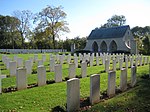Hillman Fortress
Atlantic WallBuildings and structures in Calvados (department)Fortifications in FranceMilitary history of France during World War IIMilitary history of Normandy ... and 6 more
NormandyOperation OverlordPages with empty portal templatePortal templates with redlinked portalsTourist attractions in Calvados (department)World War II sites in France

The Hillman Fortress (French: Site fortifié Hillman, German: Widerstandsnest 17) was a German bunker complex and command post built during the Second World War and located near Colleville-Montgomery in Normandy, France. The bunker complex, designated as Hill 61 and codenamed Hillman by the British, was attacked on 6 June 1944 by the Suffolk Regiment and the fortress finally surrendered the following morning. The delay in taking the bunker complex has been cited as a reason for the Allies not completing their major D-Day objective of taking Caen.The bunkers are now open as a museum and run by local volunteers.
Excerpt from the Wikipedia article Hillman Fortress (License: CC BY-SA 3.0, Authors, Images).Hillman Fortress
Rue du Suffolk Régiment, Caen
Geographical coordinates (GPS) Address External links Nearby Places Show on map
Geographical coordinates (GPS)
| Latitude | Longitude |
|---|---|
| N 49.265277777778 ° | E -0.31027777777778 ° |
Address
Site Hillman
Rue du Suffolk Régiment
14880 Caen
Normandy, France
Open on Google Maps










